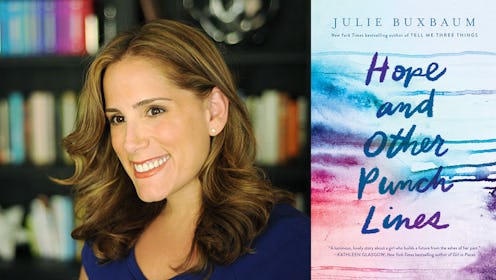Books
A New YA Book About 9/11 Is Written For Teens Who Didn't Live Through It

Though Sept. 11, 2001 was almost 18 years ago, as author Julie Buxbaum writes in her latest young adult novel Hope and Other Punchlines, "sometimes it feels like those towers are still falling and will never stop." Despite the two decades that have passed, Buxbaum believes it's more important than ever to bear witness.
"If you had told me even five years ago that I’d write a novel that had anything to do with Sept. 11, I wouldn’t have believed you," she tells Bustle. "It seemed something too big, too scary, too upsetting to touch. Until suddenly, a few years ago, it felt necessary."
"The truth is what feels like yesterday to me... feels like ancient history to the vast majority of teenage readers..."
Buxbaum was inspired to write Hope and Other Punchlines by a tweet from a teenager. Though the author says she can't remember exactly what it said, the "140 snarky characters about how annoying it was to learn about Sept. 11 in school every year on the anniversary" drove Buxbaum to tears — then to write this book.
"The truth is what feels like yesterday to me, that defining moment that split our entire world into a before and an after, feels like ancient history to the vast majority of teenage readers, many of whom were babies or hadn’t even been born on Sept. 11," Buxbaum says. "And the thought that there was this entire new generation who didn’t get it — and in all fairness how could they, they hadn’t lived through it — made me feel like I needed to urgently tell this story."
Hope and Other Punchlines follows 16-year-old Abbi Goldstein, who has been known as Baby Hope for most of her life, thanks to an iconic photograph taken of her on the morning of Sept. 11. The fictional Baby Hope image was inspired by devastating real-life photographs taken that day, and the idea came to Buxbaum "in that weird way that sometimes happens for novelists, fully formed, an image seared in my brain." When Abbi meets Noah Stern, who also has a personal connection to Sept. 11, she starts asking some difficult questions about the history behind the photograph.
While the fictional photo becomes the main reference point in the novel, Buxbaum paints a sharp picture of the realities of that day. She writes about everything from the perfect blue sky that sat above it all to the estimated 200 people that jumped from the Towers before their collapse, who "with the exception of one couple, who held hands as they fell... went one by one, as if they'd been waiting in an unfathomable line." These moments will surely be an emotional gut-punch to those readers who lived through Sept. 11, but for many teens, it may be the first time they learn about specific, gruesome details of that day.
"One of the challenges of this book was writing to two very different audiences: the people who lived through it and have an immediate visceral reaction to the material, and those who see it only through the lens of history," says Buxbaum. "My biggest hope is that both readerships get something out of this book."
"I’ve always found it deeply disturbing how little we discuss Sept. 11 Syndrome in our current culture."
Because her novel is set in the present day, Buxbaum also writes of the effects of Sept. 11 Syndrome on one of the characters. The real-life syndrome encompasses a variety of chronic respiratory illnesses, cancers, and other sicknesses suffered by first responders and survivors who inhaled the dust and debris that covered Ground Zero — much of which contained carcinogenic particles and chemicals like asbestos, fiberglass, mercury, and benzene.
"I’ve always found it deeply disturbing how little we discuss Sept. 11 Syndrome in our current culture. But we are nearing the point that we will have lost as many people to Sept. 11-related illnesses as we did on Sept. 11 itself," Buxbaum says. "We have a responsibility to all of [those] who are getting sick not only to pay attention, but more importantly, to fund their health care. The September 11th Victim Compensation Fund is running out of money, and absolutely needs to be replenished by Congress."
While the book poignantly examines the continued physical suffering, personal grief, and wide-scale devastation of Sept. 11, Buxbaum made a conscious decision not to fall into the trap of what some call "tragedy porn," and to instead craft a narrative that would reach readers of all ages.
"I didn’t just want to write a book that made people cry. I wanted to write a book that made people laugh and cry, not only on the same page, but sometimes within the same paragraph," Buxbaum says. "I wanted to explore the theme of how our stories make us who we are, and the myths we sometimes tell ourselves in their place. What happens when the stories we tell ourselves turn out not to be true? What do we replace them with? I think more than anything else that’s what Hope and Other Punchlines is about."